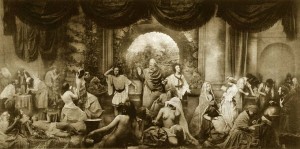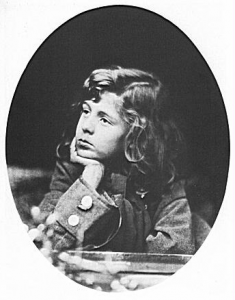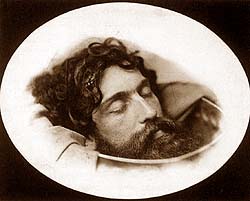
Figure 1 – Oscar Gustave Rejlander, “The Two Ways of Life, 1857” from the Royal Photographic Societ, Bath, UK, and in the public domain.
Oscar Gustave Rejlander (1813-1875) was born in Sweden and first made his name as a painter, lithographer, and copiest (of classical paintings). Therein lie his roots in classical pictoralism. There are conflicting accounts of what caused him to turn towards photography. One story has it that it resulted from a visit to the great Crystal Exhibition of 1851 in London, another that he was converted when he saw how well a photograph captured the fold of a sleeve, and a final account has him inspired by one of Fox Talbot‘s assistants.

Figure 2 – Oscar Gustave Rejlander, “Portrait of Hallam Tennyson, the son of Alfred Lord Tennyson,1863,” in the public domain.
Around 1846 he set himself up as a portraitist in the industrial Midlands town of Wolverhampton, and in 1850 he learned the wet-collodion and waxed-paper processes from Nicholas Henneman in London. He set up a photostudio and supported himself with genre work and commissioned portraiture (see Figure 2).
It was while experimenting with the issue of depth of field in portraiture that Rjlander developed combination printing – the use of multiple negatives to create a photomontage. Today in Adobe Photoshop this is straight forward. A hundred and fifty years ago in the days of analogue photography, this was difficult and pioneering. An example of this work is shown in Figure 1 above from his allegorical study “The Two Ways of Life.” The same figures are shown on the two sides of the image, depicting right the way of virtue and left the way of sin. The work was view as scandalous by many of his contemporaries. But the perceived ‘indecency’ faded when Queen Victoria bought a copy for 10-guineas as a gift for Prince Albert.
To our century the portraits, particularly those of children still bring a smile and retain a special loveliness. The religious allegories are no longer in vogue. However, we can still very much appreciate the creativity in producing something as convincing as his work, “The Head of Saint John the Baptist, 1850.” This image is so reminiscent of classic works by Titian and Caravaggio.
The was a controversial and darker side to Rejlander. He also created erotic work using circus girls, street children and child prostitutes. He created images referred to as “The Charlotte Baker series.” The most notable of these is “Mother’s Clothes,” which depicts a nude teenage girl trying on her mothers clothing. It tests even our modern sensibilities and reminds us of sinister images of children taken by Charles Dodgson (aka Lewis Carroll), a colleague and friend of Rejlander’s.
As previously discussed, near the end of Rejlander’s life he was approached by Charles Darwin to do the photographs for “The Expression of Emotions in Man and Animals, 1872.” He added a special humor and artistic quality to this early example of photographic illustration of scientific books.
* In addition to the sites hyperlinked, background for this blog was obtained from the ever useful and magnificently produced “The Golden Age of British Photography, 1839-1900.”


Pingback: Julia Margaret Cameron | Hati and Skoll Gallery
Pingback: Charles Dodgson “Alice Liddell as a beggar-maid from the story of Cophetua, 1858,” Favorite Photographs for 2013, #2 | Hati and Skoll Gallery
Pingback: Images of crime in the big apple